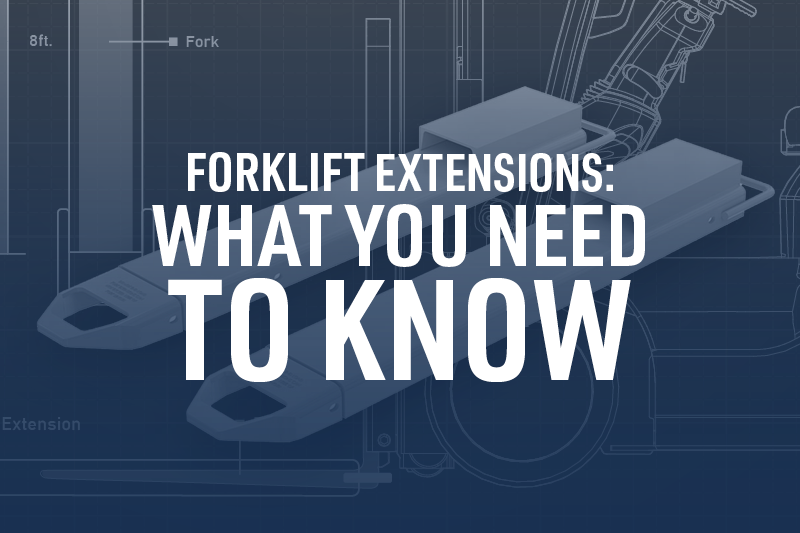Maximize Your Load: The Essential Guide to Forklift Extensions
Maximize Your Load: The Essential Guide to Forklift Extensions
Blog Article

In the world of material handling, efficiency is crucial, and one of the best ways to enhance your forklift's capabilities is through the use of forklift extensions. These simple yet effective tools allow operators to safely lift and transport larger loads, making them an essential addition to any warehouse or construction site. Understanding how to utilize forklift extensions correctly can significantly improve productivity while ensuring safety protocols are met.
Forklift extensions come in various sizes and styles to fit different types of forks and loads. Whether you are dealing with oversized pallets or uniquely shaped materials, these extensions provide the versatility needed to handle a wide range of tasks. By maximizing the length of your forks, you can reduce the number of trips required during operations, streamline your workflow, and ultimately save time and costs. In this guide, we will explore the key considerations and best practices for using forklift extensions effectively.
Understanding Forklift Extensions
Forklift extensions are specially designed attachments that increase the length of a forklift's forks, allowing it to handle larger loads than the standard forks can accommodate. These extensions are essential for businesses that frequently move bulky or oversized materials, enhancing the forklift's versatility and capability. By providing additional length, they allow operators to safely manage wider pallets and heavy items without compromising stability.
Using forklift extensions can significantly improve efficiency in various operations. When a forklift is equipped with extensions, it can transport larger loads in fewer trips, reducing the time spent on logistics. These attachments enable operators to maximize their equipment's potential, ensuring optimal use of workforce and resources. However, it is crucial to choose the right size and weight capacity of extensions to align with the forklift's specifications to maintain safe operation.
While forklift extensions enhance productivity, understanding their limitations is equally important. Overloading the forklift beyond its rated capacity can lead to dangerous situations, including tipping or loss of control. Proper training and adherence to safety guidelines are essential when utilizing these extensions. Operators should also regularly inspect the extensions for wear and tear, ensuring they remain in good condition for safe and effective use.
Types of Forklift Extensions
There are several types of forklift extensions designed to meet varied loading needs and enhance the versatility of forklifts. The most common type is the standard fork lift extension, which can increase the length of the forks without altering the overall structure of the forklift. These extensions are usually made from steel and can extend the lifting capability to handle larger materials or pallets that standard forks cannot accommodate.
Another type is the double fork lift extension. This design consists of two attached forks that can distribute weight more evenly and allow for handling wider loads. Double extensions are particularly useful in industries where bulky items are frequently transported, ensuring stability and safety during lifting and maneuvering. They are also beneficial for loading and unloading from flatbed trucks or containers.
Specialty extensions are tailored for specific tasks or industries. For instance, there are extensions designed for handling pipe or tube materials, which often feature a curved design to grip cylindrical objects securely. These extensions can significantly enhance efficiency in operations that deal with unconventional loads, providing added support and greater control when lifting heavy or awkward items.
Benefits of Using Forklift Extensions
Using forklift extensions significantly enhances the versatility of your material handling operations. These extensions allow for the safe lifting of heavier and longer loads that standard forks may not accommodate. This increased capability enables businesses to handle a wider range of products, improving operational efficiency and reducing the need for multiple types of equipment. By maximizing the lift's load potential, companies can streamline their logistics and effectively utilize their resources.
Another notable benefit of forklift extensions is their ability to improve safety during material handling. With the right extensions, operators can secure oversized or awkwardly shaped items better than with standard forks alone. This improved stability minimizes the risk of load slippage and accidents, protecting both the workforce and equipment. By prioritizing safety, businesses can foster a more productive work environment while reducing the likelihood of costly injuries or damages.
In addition to enhancing safety and versatility, forklift extensions can lead to significant cost savings. Instead of investing in new forklifts specifically designed for heavier or specialized loads, companies can equip their existing forklifts with extensions. This approach not only saves money on capital expenditure but also decreases maintenance costs associated with operating multiple forklifts. As a result, organizations can maximize their load-handling capabilities without breaking the bank.
Safety Tips for Forklift Extensions
When using forklift extensions, safety should always be a top priority. First, ensure that the forklift is rated to handle the additional weight and that the load does not exceed the forklift's stability limits. Proper training is essential for operators to understand how to handle the extended load and maintain control during operation. Always check the load distribution and be aware of the center of gravity to prevent tipping.
Forklift Extension Forks
Before attaching fork lift extensions, inspect them thoroughly for any signs of wear or damage. Ensure that the extensions are compatible with the forklift’s forks and securely attached. It is crucial to follow the manufacturer’s guidelines for installation and usage. Regular maintenance checks can help identify any potential issues before they lead to accidents.
Lastly, communicate effectively with team members when working with extended loads. Use clear signals and maintain a safe distance from others in the area. Visual aids, such as markers or cones, can help define safe zones and prevent unauthorized access. By promoting a culture of safety and awareness, you can significantly reduce the risks associated with using forklift extensions.
Report this page